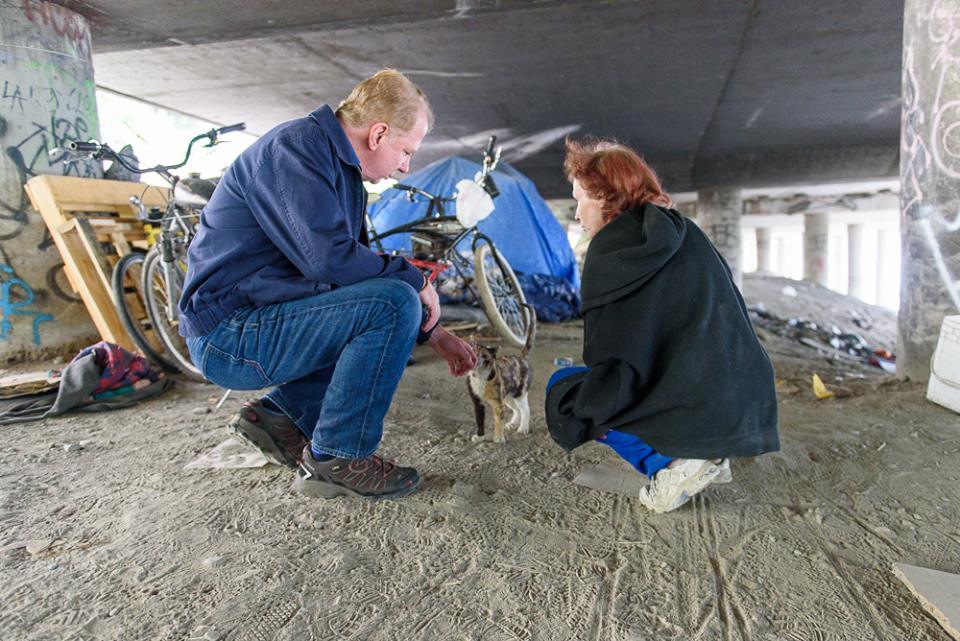Thursday afternoon, Mayor Ed Murray signed an executive order to create a service-supported 75-person dormitory for homeless Seattleites, including couples and those with pets. The “Navigation Center,” modeled after the center of the same name in San Francisco, would offer secure storage and never close. From a press release:
The service center will…provid[e] people living outside with shower, bathroom, laundry and dining facilities, a place to store their belongings, as well as round-the-clock case management, mental and behavioral health services, and connections to benefit programs and housing, all in one location. This facility will prioritize placement for individuals who are currently unsheltered and offer them a secure place to stay and access additional supports in a 24/7 program.
Murray and councilmembers Tim Burgess and Sally Bagshaw have previously visited the San Francisco site, according to the release.
The humanitarian move is a counterbalance to the mayor’s earlier—and eventual—plan to clear the Jungle, an archipelago of unlicensed encampments beside and beneath the I-5, which the mayor has strenuously claimed does not constitute “sweeps.” Yet opening the Navigation Center is consistent with the empathetic tone the mayor has struck when talking about the city’s homelessness crisis. When he declared it a formal state of emergency last year, Murray was asked by a reporter whether Seattle was attracting freeloaders by offering too many services. He replied, “To simply say that we’re not going to fund people who are sleeping on the streets, people who are sleeping in their cars when they’re seven years old…as a Roman Catholic, I just can’t go there.”
He still talks that way. From the press release: “Every single person living in an encampment has their own story, their own dignity and their own set of reasons for how they got where they are,” said Murray. “These reasons are often incredibly complicated and incredibly difficult, and we have to address these reasons at a very personal level in order to make a meaningful difference.”
Joined by a photographer, Murray visited campers beneath I-5, accompanied by staff members of Union Gospel Mission, which has been doing outreach into the Jungle at Murray’s request. He spoke with campers, and also petted a kitten and a puppy.
The Navigation Center addresses several widespread criticisms of Seattle’s homeless shelters, which are generally inhospitable to couples and pets. They also tend to open at night and close in the morning, and offer access to secure storage that’s spotty at best. Naturally, all of this exacerbates the chaos in homeless people’s lives. Sobriety requirements are another commonly cited barrier to shelter for homeless people. A spokesperson for the mayor says that a workgroup will decide on the center’s drug and alcohol policy.
There’s a dash of classic Seattle civic narcissism in the actual text of the executive order, where Murray speaks of the Seattle incarnation of this San Francisco invention as if it were ours originally: “WHEREAS, the Navigation Center model is one that, if successful in Seattle, could be developed in geographic areas outside of the city as well, in order to meet the region’s growing homelessness crisis…” On the other hand, he’s right: a Seattle solution—borrowed or not—to the regional crisis of homelessness could begin a chain reaction in other cities and counties.
According to the press release the Navigation Center will cost $1.2 million, half of it coming from the state government. The total annual homelessness budget in Seattle is roughly $50 million. In other news, the mayor’s office is proposing a new $160 million north Seattle police precinct to replace the old one built in 1984.
Due to a miscommunication from the mayor’s office, an earlier version of this post erroneously stated that this was his first visit to encampments beneath I-5. A spokesperson for the mayor clarified that he’s visited before.








